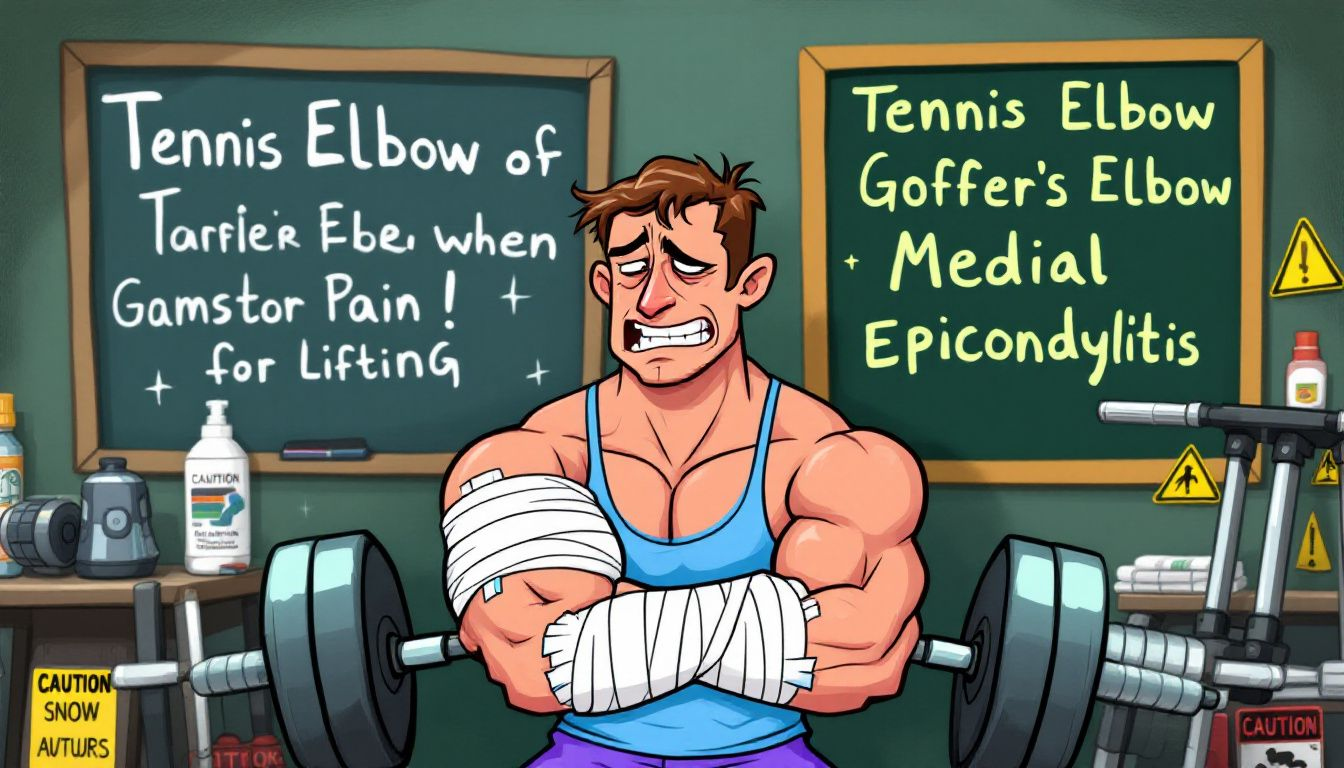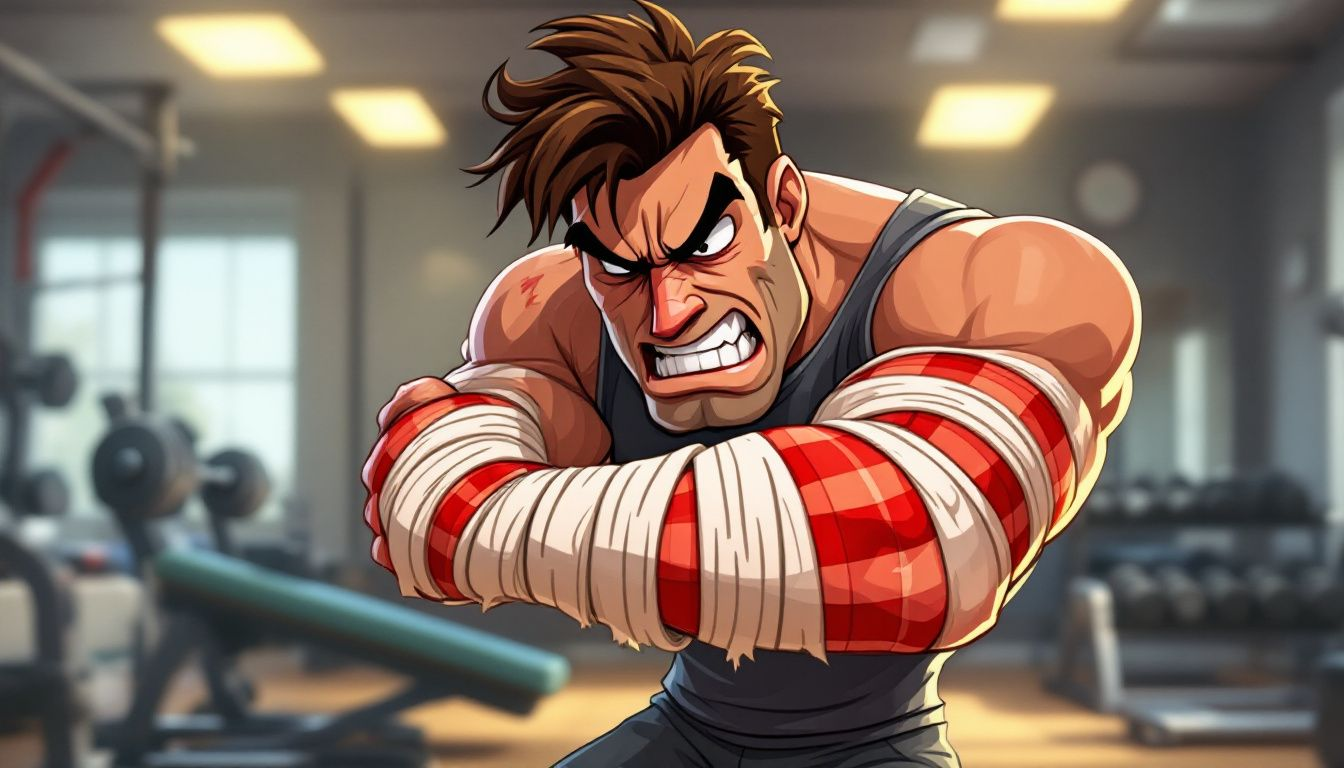Elbow hurts when lifting, right? It is usually caused by tendinitis, overuse injuries, or poor lifting techniques. You know, sometimes we overexert ourselves, and that can lead to acute injuries that we don’t want to happen.
Effective relief usually comes from a combination of rest, ice, and physical therapy. Of course, medications can help too, but surgery should only be considered as a last resort for those stubborn cases that just won’t quit.
Stay connected to the end of this post to learn about why elbow hurts when lifting, how to fix it and how to prevent it.
Why Elbow Hurts When Lifting
Elbow hurts when lifting is most often due to tendonitis, which is the inflammation of the tendons around the elbow from repetitive strain. This is a real bummer.
Other causes of elbow pain include:
- Bone fractures
- Joint arthritis
- Ligament sprains
- Bursitis (inflammation of the bursa)
You’ll notice the pain doesn’t just stay at the joint, it can radiate down your lower arm or even up towards your upper arm bone meaning the muscles in your forearm are involved.
Take a break and stop any repetitive movements. Heat therapy can also help with recovery as it increases circulation and speeds up healing.
Common Causes of Elbow Pain When Lifting
Researchers have found that overuse elbow injuries are most common in baseball (58%), then in tennis (35%), and finally in softball (17%).
As you can see, overuse injuries, poor form and acute trauma are the main culprits for many weightlifters. These factors put excessive stress on the elbow joint and can cause conditions like tennis elbow or golfer’s elbow.
Overuse
Repetitive movements especially during weightlifting can cause overuse. Doing the same exercises over and over again like bicep curls can cause tennis elbow and golfer’s elbow from the strain on the tendons and muscles.
Heavy weights and frequent activity makes it even worse and adds more stress to these areas.
If you’re not in shape, the effects of these repetitive exercises can be magnified.
Poor Form and Technique
Using poor form and technique while lifting can definitely cause elbow pain. For example, bad wrist alignment can put extra stress on the elbow. Keeping your wrist neutral during lifts helps to reduce this stress.
Good form, proper posture and warming up before workouts are all important steps to preventing elbow injuries and safe lifting.
Acute Injury
Weightlifters can also hurt their elbows because they train at high intensities and over and over again. One to four injuries were reported for every 1,000 hours of training, with the elbow being one of the most usual places for injuries.
Sudden acute injuries from poor lifting technique that overloads the elbow can cause immediate pain, swelling and limited mobility. You need to address these injuries asap to avoid further aggravation and proper healing.

Specific Elbow Conditions
Elbow pain can come from many conditions each with its own treatment plan. Two common overuse injuries that can cause this pain are tennis elbow and golfer’s elbow.
Remember these when considering causes:
- Tennis Elbow (Lateral Epicondylitis)
- Golfer’s Elbow (Medial Epicondylitis)
- Elbow joint arthritis
1. Tennis Elbow (Lateral Epicondylitis)
One common reason is lateral epicondylitis, which damages the tendons on the outside of the elbow and is also known as tennis elbow. In Olmsted County, Minnesota, a population-based study found that the disease happened to 3.4 out of every 1,000 people each year, with higher rates among people aged 40 to 49.
Tennis elbow or lateral epicondylitis is pain that radiates from the elbow down to the forearm, often with difficulty grasping objects, weak grip and acute pain during physical activities. Many people experience this from intensified training without rest or changing grip technique and causing micro tears in the extensor muscles of the forearm.
Healthcare practitioners evaluate these symptoms and may do specific tests to diagnose tennis elbow.
In fact many see significant improvement in 6 months to a year with non-operative treatment for this condition.
2. Golfer’s Elbow (Medial Epicondylitis)
Golfer’s elbow or medial epicondylitis is from repetitive strain on the inner elbow and causes medial elbow pain. This condition occurs from activities that involve lifting with the palm down and the elbow straight or gripping weights too tight.
Those who have this condition usually experience moderate pain, burning sensation, tenderness, minor swelling and weakness in the wrist and hand.
3. Elbow Arthritis
Elbow arthritis can be from:
- Joint infection
- Crystalline arthropathy
- Hemophilia
- Primary osteoarthritis
- Rheumatoid arthritis
- Trauma
Primary osteoarthritis of the elbow is rare affecting less than 2% of the general population but can cause significant pain and discomfort.
Imaging tests like X-rays and MRIs can help diagnose this condition and show degenerative changes.
Diagnosing Elbow Pain
To treat elbow pain effectively you need to diagnose accurately. If non surgical treatment fails you may need to see an orthopedic elbow specialist.
Diagnostic tests and physical examination are done to determine the cause of the pain.
Physical Examination
Generally speaking, healthcare practitioners will perform a physical examination of the elbow to determine the source of the pain by moving the arm in different directions and looking for restrictions.
By applying pressure to specific areas they can test for tenderness and identify where the pain is coming from.
Imaging Tests
In this way, diagnostic imaging tests like X-rays and MRIs are used to visualize the structures inside the elbow and determine the source of pain. These tests can differentiate between conditions like bone fractures or inflammatory conditions.
Common tests include:
- X-rays: to assess bones
- MRIs: to evaluate soft tissue and diagnose arthritis or cartilage damage.
Specialist Consultation
For persistent elbow pain you need to see orthopedic surgeons or physical therapists.
They can do a thorough examination and provide customized treatment including advanced treatment for chronic pain. If initial treatment fails you may need to be referred to an orthopedic specialist for further evaluation.

Treating Elbow Pain
As mentioned, treatment for elbow pain is rest, ice, physical therapy and medication. Non surgical treatment can relieve pain and promote healing.
You need to know when to see a doctor especially if symptoms persist with home treatment.
Rest and Ice
Resting the affected elbow and applying ice packs for 15 to 20 minutes several times a day can help relieve pain and reduce swelling. Rest allows tissues to heal, decreases inflammation and prevents further injury.
Applying ice every few hours while resting the elbow gets the most benefits.
Physical Therapy
Physical therapy strengthens forearm muscles and increases flexibility, helps in recovery and prevents further injuries. Specific strength training exercises with progressive loading can help in the recovery process.
A physical therapist can teach you exercises to strengthen and stretch the muscles to prevent re-injury.
Medications and Injections
Over the counter pain relievers like ibuprofen and naproxen can help with elbow pain. Anti-inflammatory medications can provide temporary relief from pain and swelling. In some situations, corticosteroid injections can also help with inflammation and significant pain relief that can last for several months. ( Ask you doctor first )
Platelet rich plasma injections uses a patient’s own blood to promote healing in the elbow, pain relief is usually felt after a few weeks.
Preventing Elbow Pain in Weightlifting
To have a healthy and effective weightlifting routine without elbow pain you need to follow proper form and technique, increase weights gradually and vary your workouts to spread the stress across different muscle groups.
Proper Form and Technique
Using proper technique while lifting weights is key to not putting too much stress on the elbow joint and to reduce the risk of injury. An incorrect wrist position can put too much pressure on the elbow. A firm grip distributes the effort evenly across your arm and reduces tension.
Lifting with proper form ensures that muscles and tendons are in line and protects the elbow joint.
Gradual Increase in Weight
Increasing weight incrementally helps prevent stress injuries to the elbow. Increasing weight over time strengthens the muscles without overloading the elbow joint.
Starting with lighter exercises can reduce the risk of overuse by a lot.
Varying Workouts
Mixing up your workouts can prevent repetitive strain injuries. Doing different strength training activities spreads the stress across different muscle groups and reduces the risk of overuse injuries.
Avoiding arm-stressing exercises keeps muscles and joints overall healthy.
Read More: 7 Shoulder Pain Exercises to Avoid for Injury
When Surgery is Needed
Sometimes non-surgical treatments are not enough to relieve the pain and surgery is needed. Persistent pain despite other treatment options may require an operative solution.
Severity of symptoms and impact on daily activities are key factors in deciding to undergo surgery.
If conservative measures fail, minimally invasive procedures like arthroscopy can be considered.
Minimally Invasive Surgery
Arthroscopy is a minimally invasive procedure that involves small incisions and a camera to address serious elbow issues. This reduces recovery time.
For tennis elbow a surgical procedure called lateral extensor release may be done.
Recovery and Rehabilitation
After elbow surgery the recovery process starts with splinting then rest and gradually increasing strengthening exercises.
Within 4-6 weeks patients can usually do light sports related activities. By 3 months post surgery most people will have significant improvement in range of motion and can do simple tasks.
To achieve long term success and avoid elbow pain you need to take proactive measures to prevent future injuries.
Bottom Line
Many people experience this pain, usually from overuse, poor form or conditions like tendonitis.
With all of this in mind, the usual culprits of such pain are overuse injuries, improper technique and sudden trauma each requires different approach for prevention and treatment.
To avoid elbow pain while having an effective lifting routine it’s wise to practice preventive measures like following proper form, increasing weight gradually and varying workouts. If pain persists despite these measures seek expert advice may be necessary .


